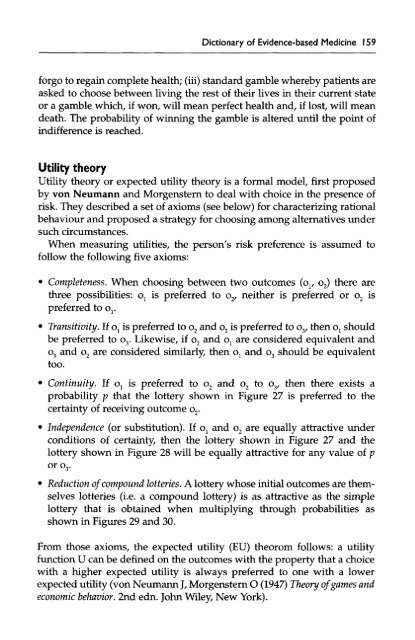Dictionary of Evidence-based Medicine.pdf
Dictionary of Evidence-based Medicine.pdf
Dictionary of Evidence-based Medicine.pdf
Create successful ePaper yourself
Turn your PDF publications into a flip-book with our unique Google optimized e-Paper software.
<strong>Dictionary</strong> <strong>of</strong> <strong>Evidence</strong>-<strong>based</strong> <strong>Medicine</strong> 159<br />
forgo to regain complete health; (iii) standard gamble whereby patients are<br />
asked to choose between living the rest <strong>of</strong> their lives in their current state<br />
or a gamble which, if won, will mean perfect health and, if lost, will mean<br />
death. The probability <strong>of</strong> winning the gamble is altered until the point <strong>of</strong><br />
indifference is reached.<br />
Utility theory<br />
Utility theory or expected utility theory is a formal model, first proposed<br />
by von Neumann and Morgenstern to deal with choice in the presence <strong>of</strong><br />
risk. They described a set <strong>of</strong> axioms (see below) for characterizing rational<br />
behaviour and proposed a strategy for choosing among alternatives under<br />
such circumstances.<br />
When measuring utilities, the person's risk preference is assumed to<br />
follow the following five axioms:<br />
• Completeness. When choosing between two outcomes (o v o 2 ) there are<br />
three possibilities: o a is preferred to o 2 , neither is preferred or o 2 is<br />
preferred to o r<br />
• Transitivity. If o a is preferred to o 2 and o 2 is preferred to o 3 , then o l should<br />
be preferred to o 3 . Likewise, if o 2 and o l are considered equivalent and<br />
o 3 and o 2 are considered similarly, then o a and o 3 should be equivalent<br />
too.<br />
• Continuity. If o l is preferred to o 2 and o 2 to o 3/ then there exists a<br />
probability p that the lottery shown in Figure 27 is preferred to the<br />
certainty <strong>of</strong> receiving outcome o 2 .<br />
• Independence (or substitution). If o l and o 2 are equally attractive under<br />
conditions <strong>of</strong> certainty, then the lottery shown in Figure 27 and the<br />
lottery shown in Figure 28 will be equally attractive for any value <strong>of</strong> p<br />
oro 3 .<br />
• Reduction <strong>of</strong> compound lotteries. A lottery whose initial outcomes are themselves<br />
lotteries (i.e. a compound lottery) is as attractive as the simple<br />
lottery that is obtained when multiplying through probabilities as<br />
shown in Figures 29 and 30.<br />
From those axioms, the expected utility (EU) theorem follows: a utility<br />
function U can be defined on the outcomes with the property that a choice<br />
with a higher expected utility is always preferred to one with a lower<br />
expected utility (von Neumann J, Morgenstern O (1947) Theory <strong>of</strong> games and<br />
economic behavior. 2nd edn. John Wiley, New York).










